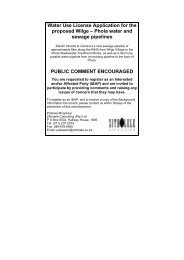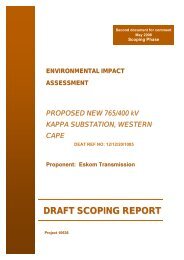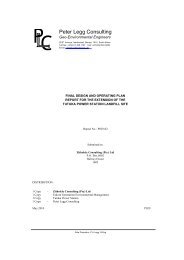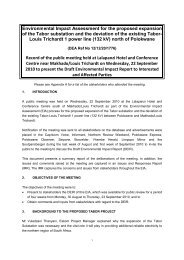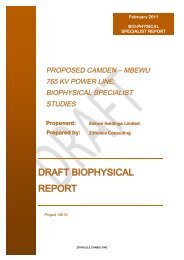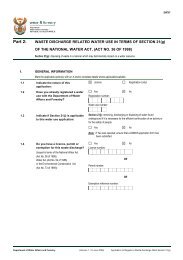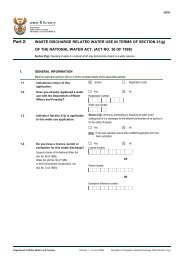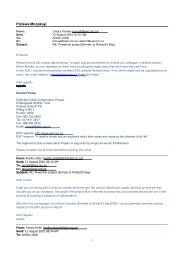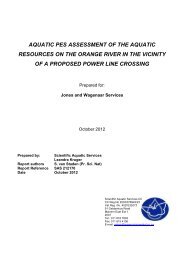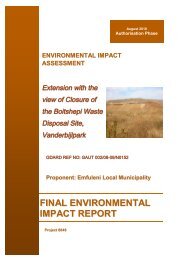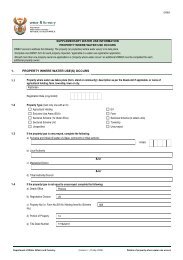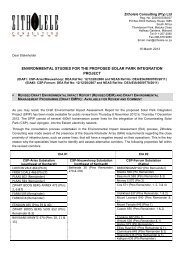Draft Basic Assessment Report.pdf - Zitholele.co.za
Draft Basic Assessment Report.pdf - Zitholele.co.za
Draft Basic Assessment Report.pdf - Zitholele.co.za
You also want an ePaper? Increase the reach of your titles
YUMPU automatically turns print PDFs into web optimized ePapers that Google loves.
BASIC ASSESSMENT REPORT<br />
Indirect Impact<br />
Waste Spillage<br />
Spillage <strong>co</strong>uld occur during the handling of waste (either ash<br />
transport system / or ash extracted by the plant).<br />
Air Quality<br />
The operation of the ESP currently struggles to <strong>co</strong>ntinually <strong>co</strong>mply<br />
with the 75 mg/Nm 3 particulate emissions limit <strong>co</strong>ntained in the air<br />
permit for the Unit due to various reasons. In addition DEA have<br />
a long term emissions reduction strategy in place that Eskom has<br />
to adhere to where the current non-site specific emissions limits<br />
are 100 mg/Nm 3 (target limit for 2015), these will be reduced to 50<br />
mg/Nm 3 in 2020.<br />
The risk is that the plant will have to start taking load losses to try<br />
and <strong>co</strong>mply with the 75 mg/Nm 3 limit, and it is anticipated that the<br />
future limits <strong>co</strong>uld not be <strong>co</strong>mplied with.<br />
Impacts to Human, Plant and Animal Health<br />
The emission limits in the Unit emissions license has been<br />
established to ensure that the air quality is not impacted on. If<br />
these limits are exceeded there is a potential that these <strong>co</strong>uld<br />
affect ambient air quality. It should be noted that Duvha’s<br />
<strong>co</strong>ntribution to the ambient air quality is very low.<br />
Impacts to Eskom’s legal <strong>co</strong>mpliance<br />
Emissions from Unit 4 at Duvha Power Station have averaged 104<br />
mg/Nm 3 prior to the shutdown. This is higher than the allowable<br />
limit of 75 mg/Nm 3 stipulated in the emissions license. Hence if<br />
Unit 4 <strong>co</strong>ntinues to operate with ESP technology, Eskom will not<br />
be <strong>co</strong>mpliant to their emissions license. In addition the more<br />
stringent limits (50 mg/Nm 3 ) will be enforced from 2020.<br />
Scale: 1 (site only)<br />
Duration: 2 (short term)<br />
Magnitude: 4 (low)<br />
Probability: 5 (will occur)<br />
Significance (SP): 35<br />
(MODERATE)<br />
Scale: 2 (local)<br />
Duration: 4 (long term)<br />
Magnitude: 8 (Moderate)<br />
Probability: 4 (high)<br />
Significance (SP): 48<br />
(MODERATE)<br />
Scale: 2 (local)<br />
Duration: 4 (long term)<br />
Magnitude: 2 (minor)<br />
Probability: 2 (low)<br />
Significance (SP): 16 (LOW)<br />
Scale: 1 (Site)<br />
Duration: 2 (short term)<br />
Magnitude: 8 (high)<br />
Probability: 4 (high)<br />
Significance (SP): 44<br />
(MODERATE)<br />
• Adhere to the ESP dusting procedures as well as the<br />
ESP inspection procedure.<br />
• In terms of mitigation ensure that the ESP is operated<br />
ac<strong>co</strong>rding to the ESP operating procedure and ensure<br />
that all maintenance is <strong>co</strong>nducted in line with the<br />
existing procedures for maintenance.<br />
• Ensure that the minimum emission standards are met.<br />
• If the current and future emission standards cannot be<br />
met install alternative technology that can meet the<br />
emission standards.<br />
• Refer air quality mitigation measures.<br />
• Ensure that the minimum emission standards are met.<br />
• If the current and future emission standards cannot be<br />
met install alternative technology that can meet the<br />
emission standards.<br />
Scale: 1 (site only)<br />
Duration: 2 (short term)<br />
Magnitude: 2 (minor)<br />
Probability: 5 (will occur)<br />
Significance (SP): 25 (LOW)<br />
Scale: 2 (local)<br />
Duration: 4 (long term)<br />
Magnitude: 6 (Moderate)<br />
Probability: 4 (high)<br />
Significance (SP): 48<br />
(MODERATE)<br />
Scale: 2 (local)<br />
Duration: 4 (long term)<br />
Magnitude: 2 (minor)<br />
Probability: 2 (low)<br />
Significance (SP): 16 (LOW)<br />
Scale: 1 (Site)<br />
Duration: 2 (short term)<br />
Magnitude: 8 (high)<br />
Probability: 4 (high)<br />
Significance (SP): 44<br />
(MODERATE)<br />
Cumulative Impact<br />
Impact to Eskom’s operations/power generation<br />
As indicated in the air quality section above, the present ESP<br />
plant is struggling to reach the required emission levels that is<br />
<strong>co</strong>ntained in the plant permit. In order to achieve these limits the<br />
plant will endure load losses, hence impacting on the existing<br />
Eskom operations at the station and also interrupting power<br />
generation.<br />
Scale: 3 (Regional)<br />
Duration: 2 (short term)<br />
Magnitude: 8 (high)<br />
Probability: 4 (high)<br />
Significance (SP): 52<br />
(MODERATE)<br />
• If the current and future emission standards cannot be<br />
met install alternative technology that can meet the<br />
emission standards.<br />
Scale: 3 (Regional)<br />
Duration: 2 (short term)<br />
Magnitude: 8 (high)<br />
Probability: 4 (high)<br />
Significance (SP): 52<br />
(MODERATE)<br />
DECOMMISIONING PHASE<br />
During the de<strong>co</strong>mmissioning phase of the development the unit will be stripped, the materials, associated buildings and structures and the <strong>co</strong>ncrete slab removed. Impact will be very similar to the <strong>co</strong>nstruction phase<br />
although more waste will be generated.



